An equestrian statue is a statue of a rider mounted on a horse, from the Latin eques, meaning 'knight', deriving from equus, meaning 'horse'. A statue of a riderless horse is strictly an equine statue. A full-sized equestrian statue is a difficult and expensive object for any culture to produce, and figures have typically been portraits of rulers or, in the Renaissance and more recently, military commanders.

Edward Clark Potter was an American sculptor best known for his equestrian and animal statues. His most famous works are the marble lions, nicknamed Patience and Fortitude, in front of the New York Public Library Main Branch
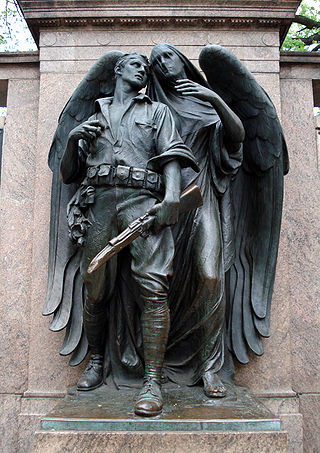
Henry Augustus Lukeman was an American sculptor, specializing in historical monuments. Noted among his works are the World War I monument in Prospect Park, Brooklyn, the Kit Carson Monument in Trinidad, Colorado and the Stone Mountain Confederate Memorial in Georgia.

David McMurtrie Gregg was an American farmer, diplomat, and a Union cavalry general in the American Civil War.
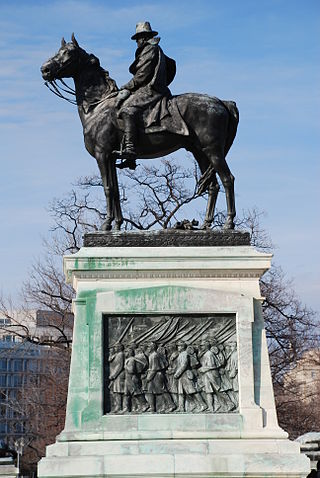
The Ulysses S. Grant Memorial is a presidential memorial in Washington, D.C., honoring American Civil War general and 18th United States President Ulysses S. Grant. It sits at the base of Capitol Hill, below the west front of the United States Capitol. Its central sculpture of Grant on horseback faces west, overlooking the Capitol Reflecting Pool and facing toward the Lincoln Memorial, which honors Grant's wartime president, Abraham Lincoln. Grant's statue is raised on a pedestal decorated with bronze reliefs of the infantry; flanking pedestals hold statues of protective lions and bronze representations of the Union cavalry and artillery. The whole is connected with marble covered platforms, balustrades, and stairs. The Grant and Lincoln memorials define the eastern and western ends, respectively, of the National Mall.

Francis Asbury, also known as the Francis Asbury Memorial, is a public equestrian statue, by American artist Augustus Lukeman, located at 16th Street and Mt. Pleasant Street, Northwest, Washington, D.C., in the Mount Pleasant neighborhood.

The Pennsylvania State Memorial is a monument in Gettysburg National Military Park that commemorates the 34,530 Pennsylvania soldiers who fought in the July 1 to 3, 1863 Battle of Gettysburg during the American Civil War. The memorial stands along Cemetery Ridge, the Union battle line on July 2, 1863. Completed in 1914, it is the largest of the state monuments on the Gettysburg Battlefield.
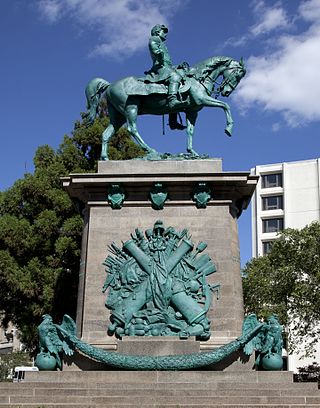
Major General George B. McClellan is an equestrian statue in Washington, D.C. that honors politician and Civil War general George B. McClellan. The monument is sited on a prominent location in the Kalorama Triangle neighborhood due to efforts made by area residents. The statue was sculpted by American artist Frederick William MacMonnies, a graduate of the École des Beaux-Arts whose best known work is a statue of Nathan Hale in New York City. MacMonnies was chosen to design the statue following a lengthy competition organized by a statue commission, led by then Secretary of War William Howard Taft. The monument was dedicated in 1907, with prominent attendees at the ceremony including President Theodore Roosevelt, New York City mayor George B. McClellan Jr., politicians, generals and thousands of military personnel.

Jakob Otto Schweizer was a Swiss-American sculptor noted for his work on war memorials.

Major General George Henry Thomas, also known as the Thomas Circle Monument, is an equestrian sculpture in Washington, D.C. that honors Civil War general George Henry Thomas. The monument is located in the center of Thomas Circle, on the border of the downtown and Logan Circle neighborhoods. It was sculpted by John Quincy Adams Ward, best known for his work on the statue of George Washington in Wall Street, Manhattan. Attendees at the dedication in 1879 included President Rutherford B. Hayes, Generals Irvin McDowell, Philip Sheridan, and William Tecumseh Sherman, senators and thousands of soldiers.

The General William Tecumseh Sherman Monument is an equestrian statue of American Civil War Major General William Tecumseh Sherman located in Sherman Plaza, which is part of President's Park in Washington, D.C., in the United States. The selection of an artist in 1896 to design the monument was highly controversial. During the monument's design phase, artist Carl Rohl-Smith died, and his memorial was finished by a number of other sculptors. The Sherman statue was unveiled in 1903. It is a contributing property to the Civil War Monuments in Washington, D.C. and to the President's Park South, both of which are historic sites listed on the National Register of Historic Places.

The Virginia Monument, also commonly referred to as "The State of Virginia Monument", is a Battle of Gettysburg memorial to the commonwealth's "Sons at Gettysburg" with a bronze statue of Robert E. Lee on his horse Traveller and a "bronze group of figures representing the Artillery, Infantry, and Cavalry of the Confederate Army". The equestrian statue is atop a granite pedestal and the group of six standing figures is on a sculpted bronze base with the figures facing the Field of Pickett's Charge and the equestrian statue of Union General George G. Meade on Cemetery Ridge. The granite pedestal without either sculpture was dedicated on June 30, 1913 for the 1913 Gettysburg reunion. On June 8, 1917, Virginia governor Henry C. Stuart presented the completed memorial to the public.

William Tecumseh Sherman, also known as the Sherman Memorial or Sherman Monument, is a sculpture group honoring William Tecumseh Sherman, created by Augustus Saint-Gaudens and located at Grand Army Plaza in Manhattan, New York. Cast in 1902 and dedicated on May 30, 1903, the gilded-bronze monument consists of an equestrian statue of Sherman and an accompanying statue, Victory, an allegorical female figure of the Greek goddess Nike. The statues are set on a Stony Creek granite pedestal designed by the architect Charles Follen McKim.
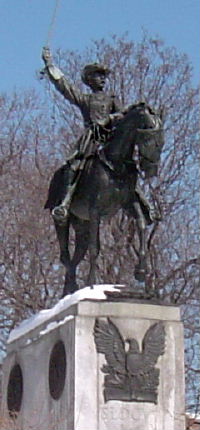
The equestrian statue of Henry Warner Slocum is a monumental statue in Brooklyn's Grand Army Plaza, in New York City. The equestrian statue, designed by sculptor Frederick William MacMonnies, was dedicated in 1905 in honor of Henry Warner Slocum, who served as a general in the Union Army during the American Civil War and later as a U.S. Representative from the state of New York.
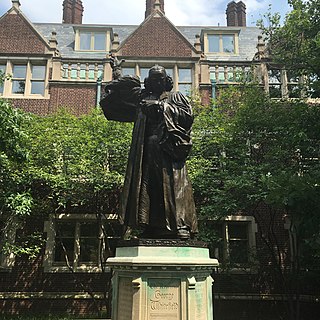
The Reverend George Whitefield is a monumental statue which once stood on the campus of the University of Pennsylvania in Philadelphia, Pennsylvania, United States. Dedicated in 1919, it was designed by sculptor R. Tait McKenzie and honors its namesake George Whitefield, Anglican cleric who was a founder of Methodism. In 2020, in reaction to the George Floyd protests, the university administration removed the statue due to Whitefield's defense of slavery.
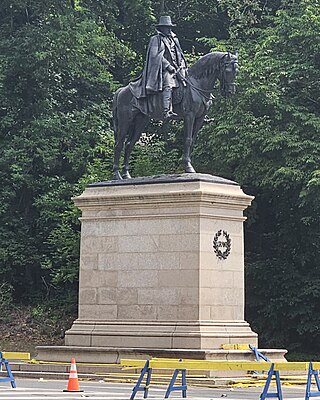
The equestrian statue of Ulysses S. Grant is a public monument in Philadelphia, Pennsylvania, United States. Located in Fairmount Park, the monument honors Ulysses S. Grant, who served as a general in the Union Army during the American Civil War and later as President of the United States. The monument was designed by Daniel Chester French and Edward Clark Potter and consists of an equestrian statue atop a pedestal. The statue was dedicated in 1899.
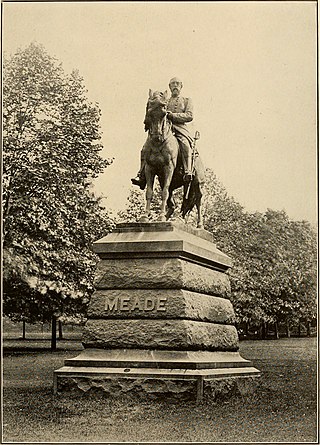
Major General George Gordon Meade is an equestrian statue that stands in Philadelphia's Fairmount Park. The statue, which was unveiled in 1887, was designed by sculptor Alexander Milne Calder and honors George Meade, who had served as an officer in the Union Army during the American Civil War and was later a commissioner for the park. The statue is one of two statues of Meade at Fairmount, with the other one being a part of the Smith Memorial Arch.
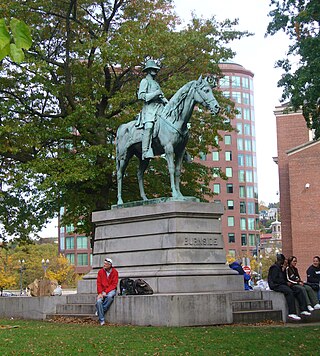
Major General Ambrose E. Burnside, also known as the Ambrose Burnside Monument, is a monumental equestrian statue in Providence, Rhode Island, United States. The statue, located in the city's Burnside Park, was designed by sculptor Launt Thompson and depicts Ambrose Burnside, an officer in the Union Army during the American Civil War who later served as the governor of Rhode Island. Ambrose had died in 1881 and the project to erect a statue in his honor began shortly afterwards. It was dedicated on July 4, 1887 in a large ceremony that included several notable guests of honor, such as General William Tecumseh Sherman, Colonel Robert Hale Ives Goddard, and the governors of both Connecticut and Rhode Island. The monument was originally located in Exchange Place, but it was moved to its current location in the early 1900s. As part of the move, the pedestal was replaced with one designed by William R. Walker.

The Frederick Lauer Monument is a monumental statue in Reading, Pennsylvania, United States. The statue was dedicated in 1885 in honor of Frederick Lauer, who was a prominent citizen and brewer from the town who served as the first president of the United States Brewers' Association. The association paid for the creation of the monument, which was designed by sculptor George F. Stephens and located in City Park.



















